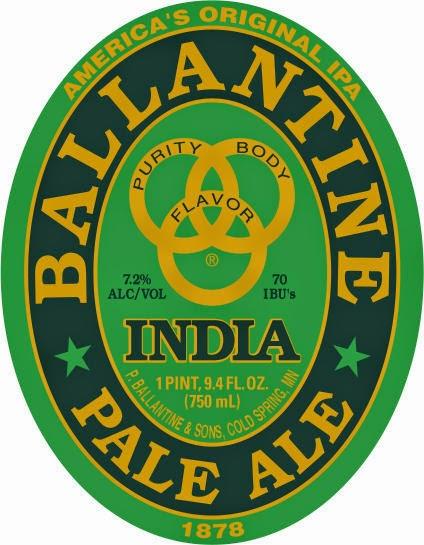When news came out that Pabst was going to resurrect Ballantine IPA I was certainty excited to try it. I was vaguely familiar with the Ballantine brand before the relaunch. As my strong sense of nostalgia took hold I did more research and became intrigued.
 |
| The original American IPA |
Due in part to mass emigration from Germany, lager became the preeminent style of beer in the US, and internationally for that matter. Based out of Newark and founded by Scottish immigrants, Ballantine was the one major US brewery that lasted well into the 20th century brewing ales and borrowing more from British traditions. Ballantine pushed the envelope in terms of styles and flavor. It was craft beer before craft beer existed. Unfortunately the brewery lost market share and closed in 1972. After a series of corporate transactions Pabst acquired the Ballantine brand.
When I read the above article it was clear that the new version was not the original recipe. The hop varieties had not been bred and developed yet. A cynic would say Pabst is trying to put an old-timey name on a new IPA for the nostalgia factor and publicity. Given how much beer and ingredients have changed since 1960, I am inclined to give Pabst the benefit of the doubt. Since Pabst is a "beer marketing company" that no longer has its own brewery, brewmaster Greg Deuhs used a homebrew setup to test and develop the recipe.
 |
| Corn is typically used in American lagers or cream ale. I'm interested to see how it works in an IPA. |
At this point I was curious as to how the modern beer compared to the original. I searched for a clone recipe and found this article from 2013. The recipe seemed to reflect the ingredients that would have been available in the early 20th century. Six-row barley used by macrobrewers today would have been the only indigenous base malt available at that time. As I mentioned when I brewed the Subway Series Stout, six-row needs an adjunct like corn due to the higher protein levels than the two row barley more commonly used and available today. I am also curious is any sweetness from the corn comes through. The hops are readily available to a homebrewer in small quantities, but likely would not be in the scale Pabst would need.
Instead of Wyeast 1056, I will be using the White Labs WLP001 I used in The Substance clone since they are both versions of the Chico strain and can be used interchangeably. I have seen rumors that the Chico yeast strain is in fact the Ballantine strain. There is a yeast company selling an Old Newark Ale strain that they claim was retrieved from a frozen yeast bank and is not Chico. I would love to try it someday to see how it compares to the ubiquitous Chico.
I scaled the recipe down to a one gallon batch. I could do a BIAB batch on my stove-top, it would be just enough to compare with the new version, and having just brewed a 5 gallon batch of The Substance clone I didn't want to have too much IPA in the house at once.
It was one of my best brewdays, so I thought. I hit all my temperatures and my volumes were right on the money. As I felt good about myself I reviewed the recipe and realized that I forgot to add the Crystal malt and I didn't boil for long enough. I should know that whenever corn is in a beer a longer boil is needed to boil off DMS which can impart a canned corn flavor like you find in Rolling Rock.
For the Crystal malt, since the recipe called for such a small quantity I put the 1.5 oz in a microwaveable bowl with some water and heated it up in the microwave to steep. Who knows if it will impart any flavor or add body, but it was worth a shot and should at least add some color.
Once the clone is done I look forward to a side-by-side comparison with new version. I have been waiting to try it until I could brew this. Everything I have heard about the new Ballantine IPA has been positive to this point.
Follow me on Instagram @wouldbebrewmaster
Like The Would-be Brewmaster on Facebook
Share what beers you are drinking with me on Untappd
No comments:
Post a Comment